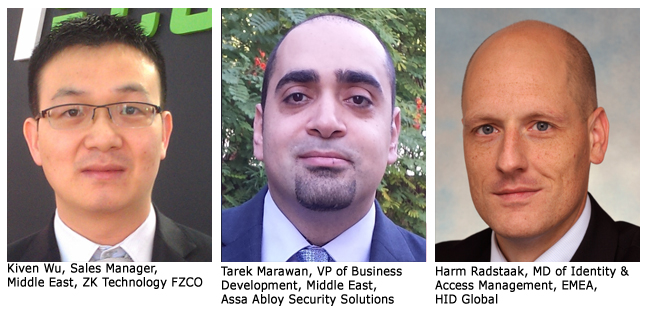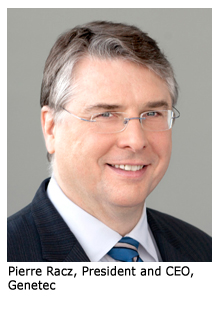Multinationals try to analyze buyers' mindsets in this region when they consider buying access control products and solutions. Besides technologies, end users here also care about the extra value that the technologies can bring to them.
Middle East buyers carry strong purchasing power. Compared to four to five years ago, Middle East buyers have become more aware of the general benefits that the new technologies can bring them. At the same time, they particularly prefer future proof security technologies that will bring them extra value to optimize their business operations and even law and policy enforcement. This kind of buying mindset becomes very obvious when they select access control products.
TIME-ATTENDANCE FEATURE IS A “MUST”
Access control products usually tend to be designed according to the local culture and lifestyles in a country. When buyers select access control products in the Middle East, the time-attendance feature is most frequently asked about and preferred because the government has clear rules on employee attendance. “It is important to have a localized approach here. We are able to customize the products according to the regional requirements and culture; for instance, the holidays in the Middle East are Fridays and Saturdays, which is different from other geographic regions. In the Middle East, the time-attendance feature is very important to end users, especially in commercial and governmental buildings solutions. End users really need the time-attendance function to enforce the government law and calculate penalties for unpunctual employees. Time-attendance features are available in different ways in our systems, and are part of the overall business reporting tools available in our access control systems. These include building space usage and occupancy calculation, people-flow measurement, entry and exit time of visitors, subcontractors, and employees. We are also developing a visitor management system to manage visitors using electronic devices. Meeting room reservation is also another newly added function,” said Tarek Ismail, Sales Director of Middle East at Tyco Security Products.
In the SMB sector, ZK Techhnology FZCO's time-attendance and access control system is popular especially in the Middle East region, especially in Saudi Arabia, Iran, the U.A.E., and Iraq. “We recently launched our latest iris and vein recognition systems, and IP video surveillance cameras with facial recognition. The camera can link with the access control system, after installing software, suitable for business buildings,” said Kiven Wu, Sales Manager of Middle East at ZK Technology FZCO.
TECH-SAVVY TECHNOLOGIES ARE PREFERRED
Due to the combination of higher purchasing power and the interest in innovative solutions, "the end users here are becoming more willing to upgrade from the standard mechanical locks to electromechanical locking systems which provide more convenience and have a more technological aspect to them. Electromechanical locks have gained more traction in the GCC than other Middle East countries," said Tarek Marawan, VP of Business Development, for Middle East at Assa Abloy Security Solutions.
Furthermore, in the Middle East, there are no set standards on locks and door hardware. Some countries such as Saudi Arabia prefer American standards (ANSI), while others prefer European standards (EN). So, there is a mixture of standards in the Middle East, depending on the country's history. “However, I would say it provides a good opportunity for a big organization such as Assa Abloy, because we have a diverse range of product lines which comply with all the different standards,” continued Marawan.
People, primarily in the GCC countries, have a high acceptance of new and savvy technologies, which accelerates the penetration of network technologies. Just like in the mature markets, the Middle East also started the adoption of NFC and identity management in certain verticals.
"From HID Global's perspective, there are several key trends for access control (in this region). Firstly, there is a growing paradigm shift from proprietary access control architectures to open and flexible solutions addressing customers business requirements for new products and technologies," said Harm Radstaak, MD of Identity & Access Management of EMEA at HID Global. "Another important trend is the increasing adoption of mobile access control, in stages, whereby smartphones will function similarly to that of a card transaction today."

OPTIMIZING BUSINESS OPERATIONS WITH INTEGRATION
Because of the high understanding toward advanced technologies and their benefits in this region, more and more end users are getting away from the traditional buying mindset, such as considering security applications or products only, and are starting to think about how security technologies can optimize their security processes and procedures and fit their security policies. "We are witnessing a rise in demand from organizations to provision a converged physical access control system (PACS) and IT identities on a single card (or smartphone) that can be used to open doors, log on to computers, and for other applications. Integrating physical access control with IT security will create a seamless user experience when securing doors, data, and the cloud. It will improve how organizations create, use and manage identities across many different applications," said Radstaak. "Migrating intelligence to the door will continue with further adoption of IP architectures and future capabilities of smartphones for access control."
Pierre Racz, President and CEO of Genetec also echoed, “Many customers approach us, initially, not just for security, but to get operational efficiency out of it too, such as in retail stores or even city wide surveillance. We discovered that access control has become a very important sensor to monitor daily business operations. In order to optimize their operations, end users mostly turn to a unified access control and video surveillance system. For example, some of our airport customers charge their employees for not bringing their badges and sometimes the fine is huge. That is because the government has imposed this specific rule on the airport. The airport would get fined without enforcing this rule.”
“In many cases, the employees who forget to bring their badges would ‘piggyback' on access granted to other employees. So, now, we are using the video with access control to monitor if an employee sneaks in with someone else. So, combining these two technologies help the end users to enforce the rule in a very cost-effective way.”
GREEN CONSTRUCTION AND BUILDING MANAGEMENT 
New technologies, like green construction, are also driving the market to adopt more new technologies. John Davies, MD at TDSi commented on the changes for the past three years in this region. “We found that the customers want more and more integrated systems, which is not just integration of different elements of the security systems, such as intruder alarms, fire, video surveillance, and access control. More often, customers also want all these security systems to be integrated into a building management system, or back-office systems, like payroll systems and time-attendance systems. From an access control point of view, we can easily know where the people are and see how these people interact. Building management systems also want to interface with access control in order to provide better granular control of heating and ventilation control or lighting systems. Although the Middle East is full of energy, governments and corporations still care about the environment green technologies. We find that Europe has a great track record in developing green technologies, but Asian customers are early adopters of these green technologies; for instance, Hong Kong has been really developing the concept of smart buildings from four to five years ago. In Europe, people are very slow to adopt. However, here, buyers are so different. They really love new technologies and ideas as long as there is a convincing return on investment or cost benefit.”
FUTURE DEVELOPMENT
The access control sector is not like the video surveillance sector, which is strictly regulated by government rules. Instead, buyers' selection is mostly dependent on their preference toward specific standards and technologies. In general, thanks to the people's acceptance of new technologies and requirements toward efficient management and long-term investment, we can expect more and more advanced technologies, especially in access control, to be introduced to this region.